Wednesday 29th June Jordan and Israel
We arrive in Jordan
We land at the Jordan Queen Alia Airport and are met by a tour guide in the terminal. He’s an older Jordanian man in his 60’s, with short-cropped grey hair.
Ripped off in New Zealand on Jordan Visa costs
As he organises our Visas and luggage I notice that the cost of a Visa, up on a notice board, is 10 Jordan Dinars, about NZ$16. This is far cheaper than the $100 each we were charged back in New Zealand by Holiday Shoppe. I queried it at the time. We have obviously been ripped off, either by our Jordan connection or the New Zealand tour sub-operators Gulliver’s.
I take a photo of the sign. I will try and get some of our money back from Holiday Shoppe or Gulliver’s.
.jpg)
The 10 Dinar visa price sign.
The guide obtains our visas and suitcases, then leads us outside the airport into the glaring heat to meet our taxi driver who will drive us to the Israel border about an hour away.
Our driver’s name turns out to be Hussein and he speaks good English. His taxi is a Peugeot 407 which makes a change from Mercedes. Noel and I sit in the back as the tour guide is coming with us part of the way.
The city of Amman
We pull out of the airport and drive through flat, semi-desert land toward Amman. Amman is the main city of Jordan and has a population of about 2 million. We drop the tour guide off at his office.
.jpg)
View from the taxi window as we leave the airport.
The tour guide is sitting on the right.
Amman appears to be quite spacious for
an ancient city, with wide streets and clear blue sky. Cars are in better
condition than Lebanon. Most of the buildings seem to be white. All but a
few of the signs around the city are in Arabic and every woman in the street
is wearing a hair-cover veil. It looks an exotic interesting place. Fresh
fruit and vegetables are on sale everywhere.
.jpg)
The central city area of Amman.
Our personable driver Hussein
Our driver Hussein is a man about 30 (picture below). He seems a very sincere and wholesome man, friendly and kind. As we travel he talks to us about conditions in Jordan at the present time.
Jordan is evidently a very traditional country, entirely Moslem. Arranged marriages are the norm.
Hussein had an arranged marriage. He says to us, "I only see my wife for first time on our wedding day. But we very happy." He said that most Moslems have 9 to 10 children. I think he said he had four young children so far.
Noel remembers him saying that he had three wives, but I must have missed that.
.jpg)
Our driver Hussein.
High Jordan moral standards
I ask him what would happen if a local girl got pregnant outside marriage and went home and told her parents. He turns and looks at me with a horrified look on his face, and says,
"Oh no! That could never happen in Jordan, If that happen here, the fathers would take that girl and kill her in the street. Oh no! That would be terrible sin. That never happen in Jordan."
I should have shut my mouth then, but I ask him if people in Jordan ever live in an unmarried state together. He seems most indignant and says that it would not be tolerated by the families. He seems disgusted that I would even bring the matter up. I wished I hadn’t. I feel like a decadent Westerner.
Divorce also seems rare among Arabs throughout the Middle East. Both Coptic and Maronite Christians forbid it, and Moslems make it very difficult.
Moslems do however offer the alternative of taking a second, third or fourth wife which probably takes care of any problems in this matter.
Jordan sights
We come up behind an old Toyota truck, with veiled women on the back tray, clothed from head to toe. Just their eyes showing.
Hussein tells us they are gypsies.
.jpg)
The truck load of gypsies.
We soon leave the city of Amman and begin driving through poor rural towns. These are all flat, and have wide streets.
We see many young men sitting or standing in the shade with apparently little or no work to do. Hussein confirms that it's hard to get jobs in these small towns.
.jpg)
Typical small Jordan townships (above and below).
.jpg)
In one village we are held up while a large herd of goats cross the road. Reminds me how flocks of sheep used to hold up traffic on New Zealand roads.
.jpg)
Goats crossing the road.
We drive on. Not a cloud in sight from horizon to horizon. No wind. Stays like this evidently for six months, this time of year.
Jordan is so traditional it is still ruled by a king. Here is a picture of him, dressed in all his finery.
.jpg)
King Abdullah II, king of Jordan.
Plan to return to Jordan next week
After our Israel trip during this week, we are booked to come back to Jordan again to fly out to Egypt. We do so and spend a highly interesting day with Hussein, touring, shopping and doing other things in the city of Amman.
Jordan is a fascinating country to visit.
We arrive at the Israel border
Eventually we arrive at the Jordan-Israel border in the Jordan Valley. We step out of the air-conditioned taxi into very hot conditions. Temperature is around 40°C.
We now have a 5 minute bus ride across the Jordan river to the Israel side of the border. There is a wide strip of ‘no mans land’ between the two nations across which tourists must travel by bus.
Trouble crossing the border into Israel
We climb into the hot Israeli shuttle bus with a noisy air conditioner going flat out and are trundled over to the customs checkpoint on the Israel side of the border.
Looking out the window we see young Israeli border guards with guns, searching two trucks that have stopped.
.jpg)
View from bus window,
young Israeli border guards with guns, searching trucks.
One girl has a mirror on a pole checking the underneath of the trucks.
.jpg)
Checking under the truck with a mirror.
We are kept waiting on the bus for about 15 minutes.
Finally we are told to get off the bus and go into the border-crossing terminal.
Here we have our first contact with the famous Jewish rudeness. There are two young girl border officials and a young man interrogating the visitors.
Perhaps Noel and I look like terrorists, for we get the third degree. More so than the other visitors it seems. All sorts of questions fired at us, particularly at me with my Arab features.
One of the border officials, a tall, plump girl about my height, is very persistent. She stands in front of me, flipping through my passport and plane tickets firing a lot of silly questions such as,
"Why you leave your family alone in New Zealand?" and "Why you come to Israel?"
I inform her that I’ve written a condensed version of the Bible and would like to see the original lands.
She stares at me and says, "I see you going Egypt. What Egypt got to do with Bible?"
She obviously has a poor knowledge of her Israelite history. I explain to her that her people were led out from Egypt by Moses.
She replies, "Is Moses in Bible?"
I tell her that he wrote the first five books.
I am becoming irritated by her attitude and show it in the tone of my voice. Noel has got through OK and is waiting for me.
So she goes and speaks to the young man official and I speak with him instead. He is much more reasonable and soon clears me to go through.
No one to pick us up
This border crossing has taken us nearly an hour. Finally we walk out of the building, towing our wheeled suitcases behind us, into the searing heat of the mid-day sun.
We walk through a guarded checkpoint and then out onto a desert road to meet the Sinbad Tour van. which is supposed to pick us up and drive us to Jerusalem, about 3 hours away.
We stand and wait and wait in the heat and sun, but no sign of the van.
Finally Noel tunes in his cell phone to Israel and uses it to call our emergency number, a Gabriel in Jerusalem, who runs Sinbad tours and is looking after our Israel part of the trip.
Noel is surprised to find that Gabriel is a man, not a woman. (The angel Gabriel in the Bible was male.)
Gabriel tells Noel that the van is there waiting for us. We look around in vain and wait a bit longer, but still no van.
It is easy to see how people can quickly die without water in extreme, dry, desert heat. We have both drained our water canisters already.
Fortunately there are a few taxis parked nearby. Finally a taxi driver, an older Jewish man comes over to us. We explain our predicament and he calls Gabriel again on his own cell phone and speaks to him in Arabic. He finally discovers that we have been dropped off at the wrong border crossing, or Gabriel has got the border-crossings mixed up. The correct border crossing where the Sinbad van is waiting is many kilometres south, about an hour closer to Jerusalem.
.jpg)
The Jordan River Terminal where we waited in vain to be picked up.
Gabriel to the rescue
The Jewish taxi driver hands me his cell phone and I speak with Gabriel myself. He apologises and says that a mistake has been made and that the taxi driver he just spoke to would arrange for a taxi van to take us to meet the bus he sent to the other border crossing to pick us up. He assures me there will be no cost to us.
So the taxi driver who rang, takes us over to another Jewish taxi driver with an air-conditioned van (most welcome) and off we go.
This driver doesn’t appear to speak any English except to tersely say, "Put on your seatbelt please."
(Later, this evening, when I think about all this, I suspect some possible corruption by the Jordan organiser, with his $100 visa fees, informing our New Zealand travel agency there is no bus from Israel to Egypt (there is), and insisting that we travel back to Jordan from Israel to fly to Egypt, and also the possibly shorter taxi ride.)
About an hour later we arrive at the other border crossing and board the van, or rather, the small bus, originally sent to pick us up. The driver is a friendly Arab.
.jpg)
The original bus (on right) which has been waiting for us
about two hours.
Entry into Jerusalem
Soon we are driving in this small bus, heading up from Jericho to Jerusalem. This is the road where the famous Good Samaritan story told by Jesus was set.
I feel quite excited to see Jerusalem at last.
.jpg)
Road up to Jerusalem.
The countryside is barren and brown. As we climb higher and draw near to Jerusalem, we see an occasional unsightly Bedouin Arab camp here and there on the hillsides, with their black tents, shacks, goat herds and old pick-up trucks.
.jpg)
Bedouin Arab camp on way to Jerusalem.
Finally we drive into Jerusalem. It is a much bigger and hillier city than I had imagined and has a modern motorway winding through the middle.
.jpg)
The motorway of Jerusalem.
Our hotel on the Mount of Olives
We drive along this motorway to the central Mount of Olives area and are dropped outside the Seven Arches Hotel (formerly the Inter-Continental).
Noel, as usual has to tip our bus driver and also a hotel porter who takes our luggage.
This well-sited hotel, on the top of the Mount of Olives (where Jesus ascended into heaven, and where he will return at his second coming) overlooks thousands of tombstones on the slopes of the Mount of Olives, down to the Kidron Valley below. Across the valley, on the hill top opposite, are the walls of the Old City part of Jerusalem.
Our hotel is located in a now Palestinian area of Jerusalem and is run by Palestinian Arabs.
Jerusalem has clear blue skies and pleasantly warm temperatures, but is rather windy on this hill top.
.jpg)
The Seven Arches Hotel on the Mount of Olives.
.jpg)
The ornate foyer of the hotel.
The Seven Arches Hotel is very large and it is a long walk to our room. However it turns out that we have a corner room and windows that look across the valley to the old city. Quite spectacular. Rather hard beds however.

View from our hotel window across the valley toward the Old City.

View from our hotel window of the hotel entrance.
Our room key has a huge heavy glass block attached. Evidently this is to encourage us to leave the key at reception when we go out, same as in Bcharre, Lebanon.
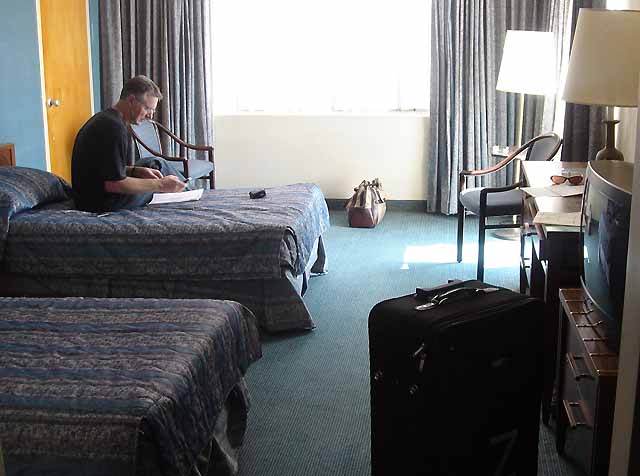
Our hotel room.
.jpg)
The bathroom – the toilet is half full of water. The rapid emptying of this water does the flushing and then it refills.
A bus load of Hasidim Jews visit a tomb
As we look out the hotel window we suddenly see an amazing site. A bus pulls up and about 60 cheerful looking Hasidim Jewish men, complete with black suits, white shirts, hats, pigtails, beards and glasses, file out and proceed down the hill to one of the large enclosed tombs. They remain clustered inside and around this tomb for about an hour.
Noel and I learn later that these Hasidim Jews like to pray at the tombs of Holy Men. They burn candles and write messages or prayers on pieces of paper and leave them in the tomb.
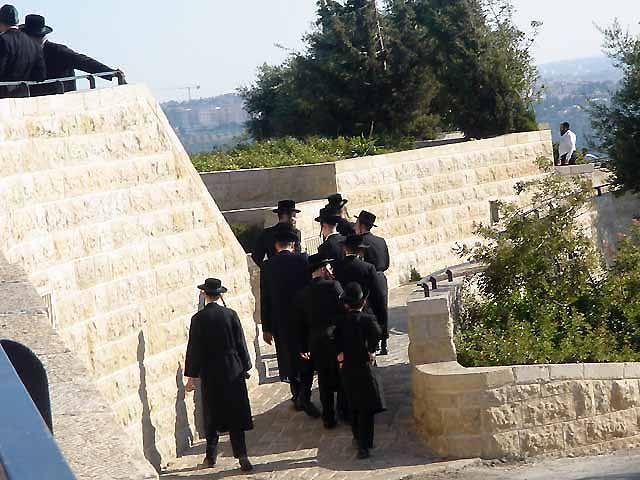
Hasidim Jews walking down to the tombs.
An Arab meal of falafel
We decide to go out for a walk around 5 pm to explore and have something to eat.
We cross the road outside the hotel to look down on the tombs and get a closer look at what the Hasidim Jews are doing.
Noel gets badgered by a persistent old Arab to take a ride on his donkey. He refuses but the man keeps pestering him. The smell of donkey poo is quite strong in the hot sun.

Noel getting pestered to take a donkey ride.
As we walk off we see the Hasidim Jews coming back up from the tomb to their bus.
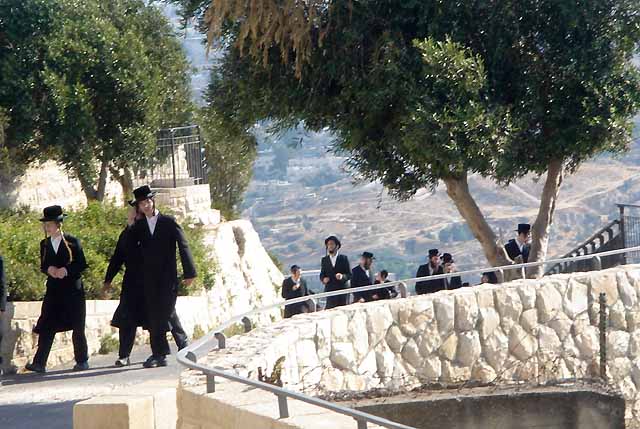
Hasidim Jews returning to their bus.
We walk further down the road and decide to break one of the basic travel rules listed in all travel books, ‘Never eat in a grotty, deserted eating place’. We do so because we’re hungry and there doesn’t seem to be any other place around. So we enter an empty, grotty little Arab food café, not too far down the road from our hotel.
We decide to try out the popular falafel, which are fried balls of chickpeas, onion and herbs, plus vegetables and pita bread. The friendly owner, a man about my age (late 50’s) is delighted to have some customers and comes out to serve us beaming.
When he has done so, he comes over and sits with us at our table and seems to enjoy speaking with us.
He pours more strong olive oil on my food, (far too much) and shows me how to cut the hollow pita breads in half and make pockets in which to pack the falafel. It seems a lot more sensible than the hamburger system where food squishes out the edges as you eat.
We explore the Kidron Valley
After our meal we walk further down the road, which runs along the side of the Mount of Olives northward and we turn left and go down into the Kidron Valley area. We notice that the hot water tanks on the houses exposed to the sun on the roofs of the houses and are mostly painted black. A simple method of solar water heating.
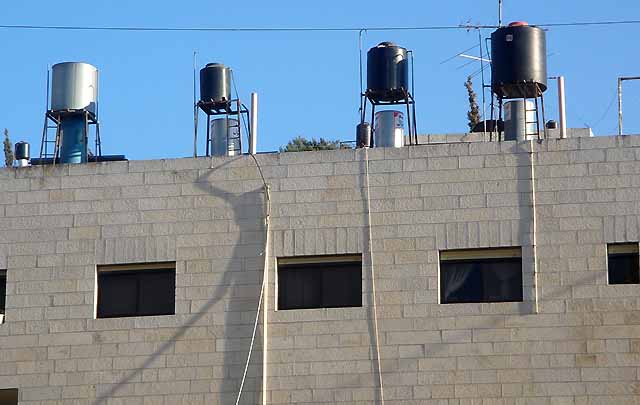
Arab solar water heating on roofs of buildings.
We then leave the road and walk up the Kidron Valley itself, back south again. This area is full of brown, straw-like grass, burnt rubble, rocks, thistles, olive trees and garbage. It smells faintly like a refuse tip.
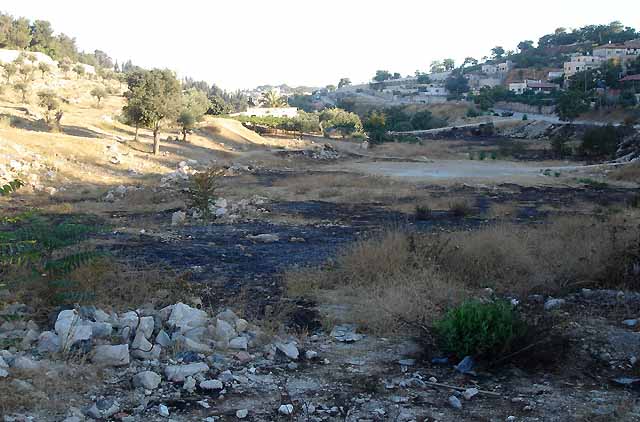
The Kidron Valley.
The old walled city of Jerusalem is up the hillside on our right.
This valley once contained the Kidron Brook and is mentioned often in the Bible. We can hear the water of the old brook running beneath our feet in a pipe.
We walk on further and come to more garbage, from which the smell is coming, and even worse thorns with large nasty prickles, also old graves, and signs of drug use.
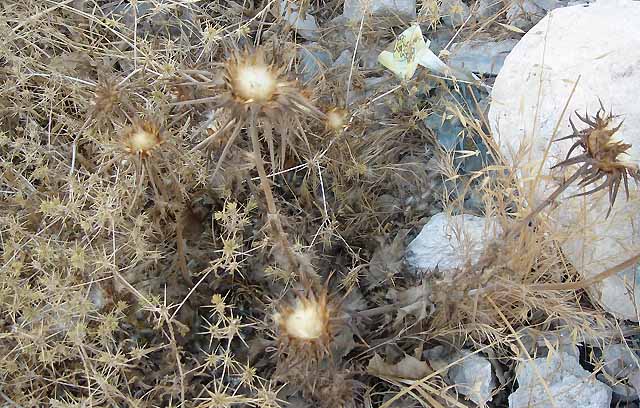
Nasty common thorns, probably the type from which
the crown of thorns of Jesus was made.
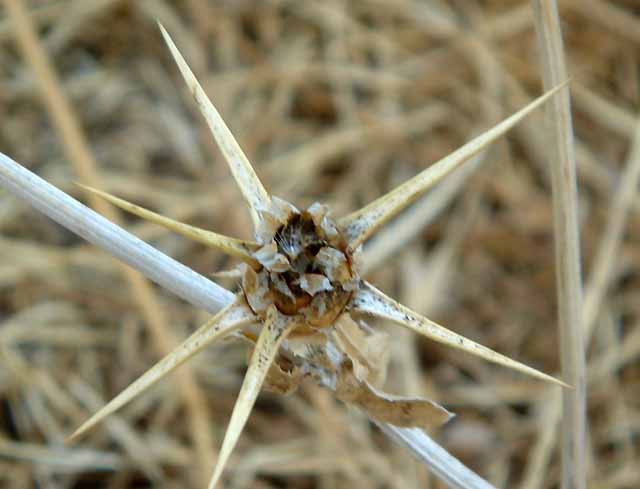
Close-up of one of the thorns.
Finally our way is blocked by the fence to the Garden of Gethsemane, more olive trees and some old stone houses with fences and barking dogs.
So we find a dusty narrow road leading up out of the valley towards the old city and take that. To our great surprise we come across a tethered camel.

The tethered camel.
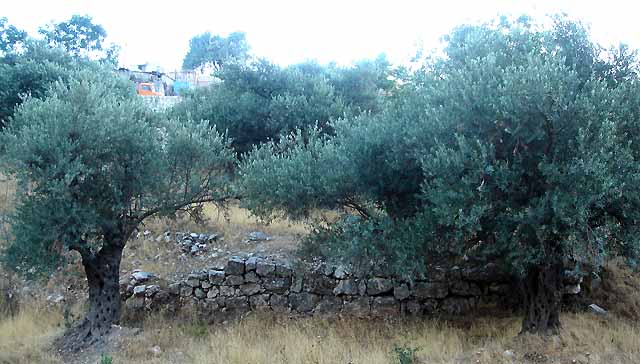
Olive trees near the Garden of Gethsemane
As the sun is setting, we see a beautiful gold cupola dome on an Eastern Orthodox type church among the trees up on the hillside to our left.
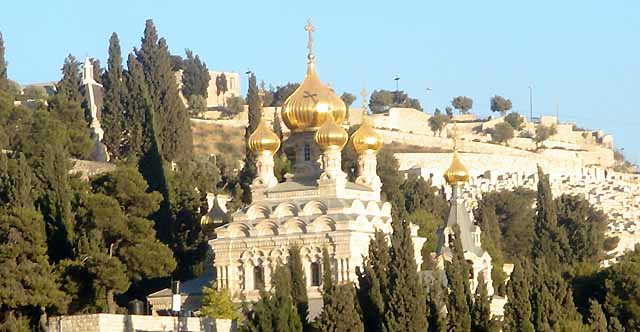
Eastern Orthodox type church.
Back to our hotel at sunset
We walk around the Garden of Gethsemane and then up the hillside to our hotel, through the thousands of old tombs which line the hillside.

Some of the thousands of tombs on the sides of the Mount of Olives
On the way we find a long black millipede on the path, about eight inches or 200 mm long. I take a close-up photo but forget to switch the camera to close-up mode, so the picture is out of focus.
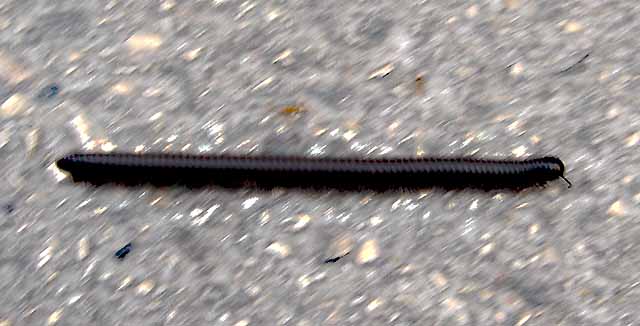
Eight inch long black millipede.
Our hotel room is a bit hot from the evening sun streaming through the windows.
Although the air conditioner sounds like it’s working, it’s not cooling the air.
Later I recharge my Ipod using a computer in the hotel office. The computer is totally clogged up with spyware and a million cookies, but I manage to clear enough of it away to get it working at a reasonable speed.
I also send off an airmail to the
family.

